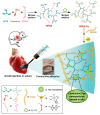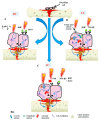Electrically Conductive Materials: Opportunities and Challenges in Tissue Engineering
- PMID: 31487913
- PMCID: PMC6770812
- DOI: 10.3390/biom9090448
Electrically Conductive Materials: Opportunities and Challenges in Tissue Engineering
Abstract
Tissue engineering endeavors to regenerate tissues and organs through appropriate cellular and molecular interactions at biological interfaces. To this aim, bio-mimicking scaffolds have been designed and practiced to regenerate and repair dysfunctional tissues by modifying cellular activity. Cellular activity and intracellular signaling are performances given to a tissue as a result of the function of elaborated electrically conductive materials. In some cases, conductive materials have exhibited antibacterial properties; moreover, such materials can be utilized for on-demand drug release. Various types of materials ranging from polymers to ceramics and metals have been utilized as parts of conductive tissue engineering scaffolds, having conductivity assortments from a range of semi-conductive to conductive. The cellular and molecular activity can also be affected by the microstructure; therefore, the fabrication methods should be evaluated along with an appropriate selection of conductive materials. This review aims to address the research progress toward the use of electrically conductive materials for the modulation of cellular response at the material-tissue interface for tissue engineering applications.
Keywords: biomaterials; cell response; electrically conductive materials; interface; nanomaterials; regenerative medicine; tissue engineering.
Conflict of interest statement
The authors declare no conflict of interest.
Figures










Similar articles
-
Electrically conductive biomaterials based on natural polysaccharides: Challenges and applications in tissue engineering.Int J Biol Macromol. 2019 Dec 1;141:636-662. doi: 10.1016/j.ijbiomac.2019.09.020. Epub 2019 Sep 5. Int J Biol Macromol. 2019. PMID: 31494165 Review.
-
Multifunctional Conductive Biomaterials as Promising Platforms for Cardiac Tissue Engineering.ACS Biomater Sci Eng. 2021 Jan 11;7(1):55-82. doi: 10.1021/acsbiomaterials.0c01422. Epub 2020 Dec 14. ACS Biomater Sci Eng. 2021. PMID: 33320525 Review.
-
Electrically conductive coatings in tissue engineering.Acta Biomater. 2024 Sep 15;186:30-62. doi: 10.1016/j.actbio.2024.08.007. Epub 2024 Aug 14. Acta Biomater. 2024. PMID: 39128796 Review.
-
Oligoaniline-based conductive biomaterials for tissue engineering.Acta Biomater. 2018 May;72:16-34. doi: 10.1016/j.actbio.2018.03.042. Epub 2018 Apr 4. Acta Biomater. 2018. PMID: 29625254 Review.
-
Electrically conductive materials for in vitro cardiac microtissue engineering.J Biomed Mater Res A. 2020 May;108(5):1203-1213. doi: 10.1002/jbm.a.36894. Epub 2020 Feb 20. J Biomed Mater Res A. 2020. PMID: 32034936 Review.
Cited by
-
Bioactive potential of natural biomaterials: identification, retention and assessment of biological properties.Signal Transduct Target Ther. 2021 Mar 19;6(1):122. doi: 10.1038/s41392-021-00512-8. Signal Transduct Target Ther. 2021. PMID: 33737507 Free PMC article. Review.
-
Electrical Stimulation Therapy and HA/TCP Composite Scaffolds Modulate the Wnt Pathways in Bone Regeneration of Critical-Sized Defects.Bioengineering (Basel). 2023 Jan 6;10(1):75. doi: 10.3390/bioengineering10010075. Bioengineering (Basel). 2023. PMID: 36671647 Free PMC article.
-
MXene functionalized collagen biomaterials for cardiac tissue engineering driving iPSC-derived cardiomyocyte maturation.NPJ 2D Mater Appl. 2023;7(1):44. doi: 10.1038/s41699-023-00409-w. Epub 2023 Jun 27. NPJ 2D Mater Appl. 2023. PMID: 38665478 Free PMC article.
-
Noncovalent functionalization of carbon nanotubes as a scaffold for tissue engineering.Sci Rep. 2022 Jul 14;12(1):12062. doi: 10.1038/s41598-022-16247-7. Sci Rep. 2022. PMID: 35835926 Free PMC article.
-
Theoretical Encapsulation of Fluorouracil (5-FU) Anti-Cancer Chemotherapy Drug into Carbon Nanotubes (CNT) and Boron Nitride Nanotubes (BNNT).Molecules. 2021 Aug 13;26(16):4920. doi: 10.3390/molecules26164920. Molecules. 2021. PMID: 34443508 Free PMC article.
References
-
- Kargozar S., Mozafari M. Nanotechnology and Nanomedicine: Start small, think big. Mater. Today Proc. 2018;5:15492–15500. doi: 10.1016/j.matpr.2018.04.155. - DOI
-
- Zarrintaj P., Moghaddam A.S., Manouchehri S., Atoufi Z., Amiri A., Amirkhani M.A., Nilforoushzadeh M.A., Saeb M.R., Hamblin M.R., Mozafari M. Can regenerative medicine and nanotechnology combine to heal wounds? The search for the ideal wound dressing. Nanomedicine. 2017;12:2403–2422. doi: 10.2217/nnm-2017-0173. - DOI - PubMed
Publication types
MeSH terms
Substances
LinkOut - more resources
Full Text Sources

